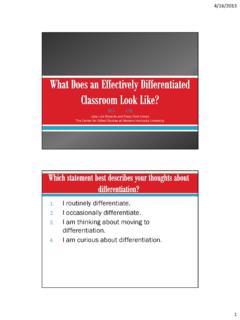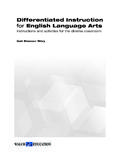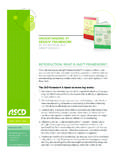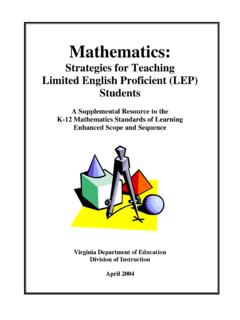Transcription of Examining differentiated instruction: Teachers …
1 Research in Higher Education Journal Examining differentiated instruction, Page 1 Examining differentiated instruction: Teachers respond Brenda Logan Armstrong Atlantic State University ABSTRACT Today s classrooms are more diverse than ever. In fact, research shows that there will be a steady increase in Hispanic, Asian Americans, and African American students in the coming years. Therefore, differentiated instruction may be the panacea that educators are searching for. This paper commences with an introduction and then segways into a review of the literature that will elaborate on the following areas: the major principles of differentiated instruction, the essentials necessary for differentiating, ways to implement, the clich s, barriers, and myths surrounding the practice, and the research studies and theories supporting differentiation.
2 The last section explains the results of a survey administered to middle school Teachers to determine their level of knowledge in providing differentiated instruction in the classroom. Keywords: understanding differentiated instruction, essentials in differentiating, studies in differentiation, theories and differentiation, summarizing the support for differentiation, myths and barriers in differentiation Research in Higher Education Journal Examining differentiated instruction, Page 2 INTRODUCTION Differentiation is not a novel concept. The one-room schoolhouse is an ideal example of how Teachers have attempted to meet the needs of all students centuries ago (Anderson, 2007).
3 Though differentiated instruction seems to be a broad term, it mainly refers to those classroom practices embodying student learning styles, interest, and prior knowledge (Benjamin, 2002). Understandably, state standards represent the knowledge to be taught but differentiated instruction gives a meaningful way to teach those required standards (Protheroe, 2007). Today s classrooms are now defined by diversity. By 2035, students of color will be a majority in schools with increasing populations of children of immigrant and migrant families. Half of all children will live in single-parent homes at some time during their school years (Tomlinson & Brighton, 2003). In the same way, the major purpose of differentiated instruction is to maximize each student s growth by meeting each student where he or she is (Hall, Strangman & Meyer, 2003).
4 On the other hand, traditional instruction has been equated with Teachers who teach to the middle or use the one-size-fits-all approach (Rock, Gregg, Ellis, & Gable, 2008). One popular way of adopting differentiated instruction has been developed by Carol Ann Tomlinson (1999). THE REVIEW OF THE LITERATURE The review of the literature covers the following sections: 1) Major principles of differentiated instruction 2) Essential components 3) Suggestions for implementing differentiated instruction 4) Myths, clich s, and barriers in differentiated instruction and the 5) Research studies and theories supporting differentiation. Major Principles In order to understand differentiated instruction, the principles for practicing must be articulated.
5 O Brien & Guiney (2001) clearly enumerated these as major principles of differentiated instruction: 1) Every child can learn and every teacher can learn 2) All children have the right to high quality education. 3) Progress for all will be expected, recognized, and rewarded. 4) Learners in a classroom have common needs, distinct needs, and individual needs. Other principles that are paramount to understanding differentiated instruction can be traced in Edyburn s article (2004) entitled, Technology Supports for differentiated Instruction. The principles are adapted from the work of Carol Ann Tomlinson (1999) and simply echo that Teachers should focus on the essentials in learning, should attend to student differences, should collaborate with students on learning, and should not separate assessment from instruction.
6 The teacher should constantly modify the content, process, and products produced from learning. Teachers must also allow students to participate in respectful work while maintaining a flexible working relationship. Essential Components In conjunction with the principles, Teachers must engage in several key components for successfully conducting differentiated instruction in the classroom. Anderson (2007) insisted that the teacher must provide students with choice, flexibility, on-going assessment, and creativity in Research in Higher Education Journal Examining differentiated instruction, Page 3 differentiating the concepts taught. At the same time, a teacher has to understand how students process and develop understanding of concepts and skills.
7 Additionally, the teacher has to know the level of knowledge students must tap into when asked to develop products or projects to demonstrate learning. Tomlinson identified three components that should be differentiated (Hall, Strangman & Meyer, 2003): content (elements and materials used in reaching learning goals and in teaching concepts, principles, and skills that students will learn), process (how you will teach the content, flexible groups or whole-group discussion of content or small groups or paired groups; groups are not fixed), and products (students are allowed choices in products or final assessments which should offer a variety of ways for expression, degree of difficulty, and types of evaluation).
8 Langa & Yost (2007) reminds that three key components for differentiating is to assess each child s readiness level (where they are in relation to a particular understanding or skill), interest level (their curiosity or passion for a particular topic or skill), and learning profile/style (how students learn as influenced by intelligence, preferences, gender, culture or learning style) before modifying content, process, and products. The teacher should use assessment data gathered from each child during the beginning of the school year. However, the teacher should continue to collect data daily on students readiness for particular skills and ideas, their interests, and their learning profiles/styles.
9 Here are some possibilities for modifying content, process, and products (Langa & Yost, 2007): Content (Materials & elements) 1. Select a variety of books and resource materials for handling variety in reading levels 2. Select specific areas of interest within the focus area 3. Use Learning contracts with students 4. Group students according to readiness levels or interest levels 5. Reteach to small groups who need support or explanations; exempt those who have mastered the material 6. Establish learning centers or stations 7. Allow students to work alone or with peers. Process (how students gain understanding of main ideas and information) 1. Use tiered activities (a series of related tasks of varying complexity) 2.
10 Use learning contracts based on readiness, interests, or learning profile of student 3. Use independent learning 4. Use choice boards, flexible grouping, reading buddies, learning centers and peer teaching Products (ways students will demonstrate their knowledge or understanding of a topic) 1. Write a story or a poem 2. Write a book report, a play, or perform a play 3. Debate or investigate an issue 4. Design a model or a game 5. Create a mural or a song 6. Compare or contrast Suggestions for Implementing differentiated Instruction In getting started with differentiated instruction, Anderson (2007) has several easy to follow suggestions. Begin with creating learning profiles.

















